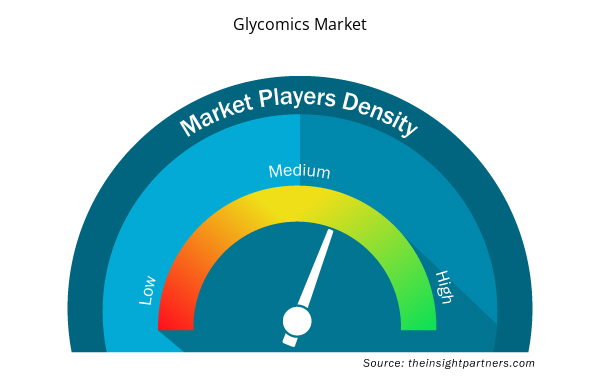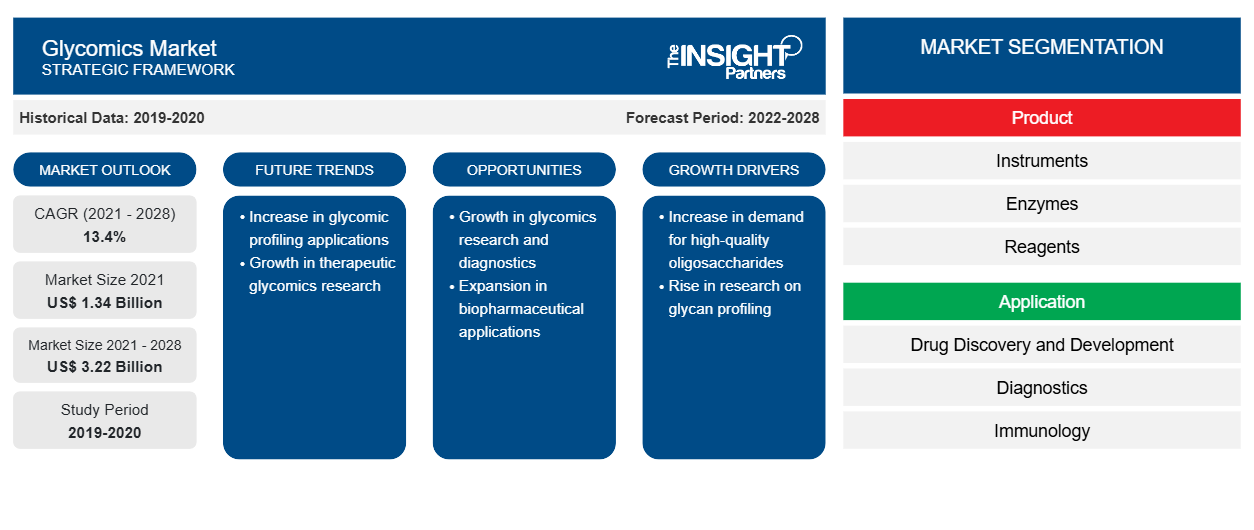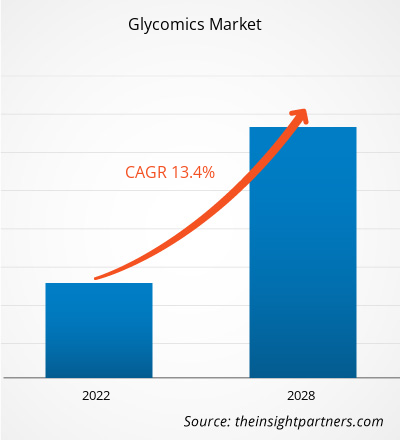[研究报告]糖组学市场预计将从 2021 年的 13.408 亿美元增长到 2028 年的 32.233 亿美元;预计2022 年至 2028 年的 复合年增长率为 13.4%。
聚糖是造成生物系统结构变异的主要原因,它们在细胞表面的表现通常被称为“糖组”。糖组学是一个新兴领域,旨在研究细胞、组织或生物体中聚糖的结构和功能。聚糖是链状结构的碳水化合物,可以游离或与脂质或蛋白质等大分子结合。它们参与多种生物过程,如蛋白质折叠、细胞信号传导和免疫识别。这些与肿瘤病、自身免疫病等多种疾病有关。糖组学研究的增加、研发投入的增加以及利用糖组学治疗各种疾病,推动了新治疗工艺的开发,从而推动了糖组学市场的发展。然而,高昂的设备成本和熟练专业人员的短缺阻碍了整体市场的增长。该报告对糖组学市场提供了见解和深入分析,强调了各种参数,例如市场趋势、技术进步、市场动态以及全球主要市场参与者的竞争格局分析。它还包括 COVID-19 大流行对所有地区市场的影响。由于 COVID-19 大流行,许多卫生当局将重点放在与大流行相关的护理上。最近,更多关于冠状病毒的研究发现了依赖于病毒使用人类聚糖的感染机制。例如,GlycoNet 的研究人员证明 COVID-19 病毒通过与糖脂结合进入细胞。研究人员现在正在测试令人担忧的 COVID-19 变体是否正在改变其聚糖结合特性。因此,由于全球研究的增加,COVID-19 大流行对糖组学市场产生了积极影响。
定制此报告以满足您的需求
您可以免费定制任何报告,包括本报告的部分内容、国家级分析、Excel 数据包,以及为初创企业和大学提供优惠和折扣
- 获取此报告的关键市场趋势。这个免费样品将包括数据分析,从市场趋势到估计和预测。
基于地理位置的洞察
根据地域划分,糖组学市场分为北美洲(美国、加拿大和墨西哥)、欧洲(法国、德国、英国、西班牙、意大利和欧洲其他地区)、亚太地区(中国、印度、日本、澳大利亚、韩国和亚太地区其他地区)、中东和非洲(沙特阿拉伯、阿联酋、南非和中东和非洲其他地区)以及南美洲和中美洲(巴西、阿根廷和南美洲和中美洲其他地区)。
市场洞察
糖组学在各种疾病中的应用日益广泛,推动了新治疗工艺的发展
随着科学家们将精力集中在糖组学领域,他们开始了解有关体内聚糖和糖基化功能的重要细节,包括细胞通讯以及这些因素可能揭示的疾病发展和诊断信息。最大和增长最快的应用类别是药物发现和开发,这主要是由于制药和生物技术公司研发的增加以及大学研究机构药物发现研究活动的扩大。例如,2020 年 4 月,为了将一种尖端的癌症检测工具商业化,糖组学研究所和阿德莱德大学的研究人员与 Sienna Cancer Diagnostics Ltd. 签署了独家许可协议。这些研究人员创造了一种名为 SubB2M 的特殊蛋白质,它只附着在一种只存在于癌细胞中的糖分子上。这种蛋白质可能会彻底改变癌症的检测。此外,2022年1月,国家卫生和医学研究委员会(NHMRC)向糖组学研究所的研究人员提供了总额超过1,100,000亿美元的资助,帮助他们研制治疗多重耐药性淋病感染的新药。
基于产品的洞察
根据产品,全球糖组学市场分为酶、仪器、试剂盒和试剂。2021 年,酶部分将占据市场的最大份额;预计在 2022 年至 2028 年期间,酶将在糖组学市场中实现最高复合年增长率。
基于应用的洞察
根据应用,全球糖组学市场细分为药物发现和开发、诊断、免疫学、癌症等。药物发现和开发领域将在 2021 年占据最大的市场份额。然而,在预测期内,诊断领域预计将以最高的复合年增长率增长。应用领域的主要驱动因素是对孤儿病和罕见病的研究增加、对药物开发的需求增加以及对早期诊断的认识不断提高。
糖组学市场区域洞察
Insight Partners 的分析师已详尽解释了预测期内影响糖组学市场的区域趋势和因素。本节还讨论了北美、欧洲、亚太地区、中东和非洲以及南美和中美洲的糖组学市场细分和地理位置。

- 获取糖组学市场的区域特定数据
糖组学市场报告范围
| 报告属性 | 细节 |
|---|---|
| 2021 年市场规模 | 13.4亿美元 |
| 2028 年市场规模 | 32.2亿美元 |
| 全球复合年增长率(2021 - 2028) | 13.4% |
| 史料 | 2019-2020 |
| 预测期 | 2022-2028 |
| 涵盖的领域 | 按产品
|
| 覆盖地区和国家 | 北美
|
| 市场领导者和主要公司简介 |
|
糖组学市场参与者密度:了解其对业务动态的影响
糖组学市场正在快速增长,这得益于终端用户需求的不断增长,而这些需求又源于消费者偏好的不断变化、技术进步以及对产品优势的认识不断提高等因素。随着需求的增加,企业正在扩大其产品范围,进行创新以满足消费者的需求,并利用新兴趋势,从而进一步推动市场增长。
市场参与者密度是指在特定市场或行业内运营的企业或公司的分布情况。它表明在给定市场空间中,相对于其规模或总市场价值,有多少竞争对手(市场参与者)存在。
在糖组学市场运营的主要公司有:
- 默克公司
- 安捷伦科技公司
- 新英格兰生物实验室
- 赛默飞世尔科技公司
- 沃特世公司
免责声明:上面列出的公司没有按照任何特定顺序排列。

- 获取糖组学市场顶级关键参与者概览
基于最终用户的洞察
根据最终用户,全球糖组学市场细分为制药和生物技术公司、学术和研究机构以及合同研究组织。制药和生物技术公司部门将在 2021 年占据最大的市场份额,预计同一部门在预测期内将以最高的复合年增长率增长。
糖组学市场参与者采用产品发布和扩张等有机策略来扩大其全球足迹和产品组合并满足不断增长的需求。为糖组学市场做出贡献的一些主要参与者包括默克集团、安捷伦科技公司、新英格兰生物实验室、赛默飞世尔科技公司、沃特世公司、Asparia Glycomics、布鲁克公司、Takara Bio Inc.、S-BIO 和岛津公司等。
- 历史分析(2 年)、基准年、预测(7 年)及复合年增长率
- PEST 和 SWOT 分析
- 市场规模价值/数量 - 全球、区域、国家
- 行业和竞争格局
- Excel 数据集


- Microplate Reader Market
- Organoids Market
- Embolization Devices Market
- Pharmacovigilance and Drug Safety Software Market
- Single-Use Negative Pressure Wound Therapy Devices Market
- Microcatheters Market
- Rugged Phones Market
- Extracellular Matrix Market
- Advanced Planning and Scheduling Software Market
- Data Annotation Tools Market

Report Coverage
Revenue forecast, Company Analysis, Industry landscape, Growth factors, and Trends

Segment Covered
This text is related
to segments covered.

Regional Scope
North America, Europe, Asia Pacific, Middle East & Africa, South & Central America

Country Scope
This text is related
to country scope.
常见问题
Glycomics is an emerging field that aims to focus on the structure and function of glycans in a cell, tissue, or organism. Glycans are the chain-like structures of carbohydrates that are free or conjugated to macromolecules such as lipids or proteins. They contribute to a diverse selection of biological processes such as protein folding, cell signaling, and immune recognition. These are implicated in several diseases such as oncological, autoimmune, and others.
Based on product, the market is segmented into enzymes, instruments, kits, and reagents. The enzymes segment is anticipated to hold the largest share in 2021 and is expected to continue to do so during the forecast period.
Merck KGaA; Agilent Technologies, Inc.; New England Biolabs; Thermo Fisher Scientific Inc.; Waters Corporation; Asparia Glycomics; Bruker Corporation; Takara Bio Inc.; S-BIO; and Shimadzu Corporation are among the leading companies operating in the global Glycomics market.
Trends and growth analysis reports related to Life Sciences : READ MORE..
The List of Companies - Glycomics Market
- Merck KGaA
- Agilent Technologies, Inc.
- New England Biolabs
- Thermo Fisher Scientific Inc.
- Waters Corporation
- Asparia Glycomics
- Bruker Corporation
- Takara Bio Inc.
- S-BIO
- Shimadzu Corporation
The Insight Partners performs research in 4 major stages: Data Collection & Secondary Research, Primary Research, Data Analysis and Data Triangulation & Final Review.
- Data Collection and Secondary Research:
As a market research and consulting firm operating from a decade, we have published and advised several client across the globe. First step for any study will start with an assessment of currently available data and insights from existing reports. Further, historical and current market information is collected from Investor Presentations, Annual Reports, SEC Filings, etc., and other information related to company’s performance and market positioning are gathered from Paid Databases (Factiva, Hoovers, and Reuters) and various other publications available in public domain.
Several associations trade associates, technical forums, institutes, societies and organization are accessed to gain technical as well as market related insights through their publications such as research papers, blogs and press releases related to the studies are referred to get cues about the market. Further, white papers, journals, magazines, and other news articles published in last 3 years are scrutinized and analyzed to understand the current market trends.
- Primary Research:
The primarily interview analysis comprise of data obtained from industry participants interview and answers to survey questions gathered by in-house primary team.
For primary research, interviews are conducted with industry experts/CEOs/Marketing Managers/VPs/Subject Matter Experts from both demand and supply side to get a 360-degree view of the market. The primary team conducts several interviews based on the complexity of the markets to understand the various market trends and dynamics which makes research more credible and precise.
A typical research interview fulfils the following functions:
- Provides first-hand information on the market size, market trends, growth trends, competitive landscape, and outlook
- Validates and strengthens in-house secondary research findings
- Develops the analysis team’s expertise and market understanding
Primary research involves email interactions and telephone interviews for each market, category, segment, and sub-segment across geographies. The participants who typically take part in such a process include, but are not limited to:
- Industry participants: VPs, business development managers, market intelligence managers and national sales managers
- Outside experts: Valuation experts, research analysts and key opinion leaders specializing in the electronics and semiconductor industry.
Below is the breakup of our primary respondents by company, designation, and region:

Once we receive the confirmation from primary research sources or primary respondents, we finalize the base year market estimation and forecast the data as per the macroeconomic and microeconomic factors assessed during data collection.
- Data Analysis:
Once data is validated through both secondary as well as primary respondents, we finalize the market estimations by hypothesis formulation and factor analysis at regional and country level.
- Macro-Economic Factor Analysis:
We analyse macroeconomic indicators such the gross domestic product (GDP), increase in the demand for goods and services across industries, technological advancement, regional economic growth, governmental policies, the influence of COVID-19, PEST analysis, and other aspects. This analysis aids in setting benchmarks for various nations/regions and approximating market splits. Additionally, the general trend of the aforementioned components aid in determining the market's development possibilities.
- Country Level Data:
Various factors that are especially aligned to the country are taken into account to determine the market size for a certain area and country, including the presence of vendors, such as headquarters and offices, the country's GDP, demand patterns, and industry growth. To comprehend the market dynamics for the nation, a number of growth variables, inhibitors, application areas, and current market trends are researched. The aforementioned elements aid in determining the country's overall market's growth potential.
- Company Profile:
The “Table of Contents” is formulated by listing and analyzing more than 25 - 30 companies operating in the market ecosystem across geographies. However, we profile only 10 companies as a standard practice in our syndicate reports. These 10 companies comprise leading, emerging, and regional players. Nonetheless, our analysis is not restricted to the 10 listed companies, we also analyze other companies present in the market to develop a holistic view and understand the prevailing trends. The “Company Profiles” section in the report covers key facts, business description, products & services, financial information, SWOT analysis, and key developments. The financial information presented is extracted from the annual reports and official documents of the publicly listed companies. Upon collecting the information for the sections of respective companies, we verify them via various primary sources and then compile the data in respective company profiles. The company level information helps us in deriving the base number as well as in forecasting the market size.
- Developing Base Number:
Aggregation of sales statistics (2020-2022) and macro-economic factor, and other secondary and primary research insights are utilized to arrive at base number and related market shares for 2022. The data gaps are identified in this step and relevant market data is analyzed, collected from paid primary interviews or databases. On finalizing the base year market size, forecasts are developed on the basis of macro-economic, industry and market growth factors and company level analysis.
- Data Triangulation and Final Review:
The market findings and base year market size calculations are validated from supply as well as demand side. Demand side validations are based on macro-economic factor analysis and benchmarks for respective regions and countries. In case of supply side validations, revenues of major companies are estimated (in case not available) based on industry benchmark, approximate number of employees, product portfolio, and primary interviews revenues are gathered. Further revenue from target product/service segment is assessed to avoid overshooting of market statistics. In case of heavy deviations between supply and demand side values, all thes steps are repeated to achieve synchronization.
We follow an iterative model, wherein we share our research findings with Subject Matter Experts (SME’s) and Key Opinion Leaders (KOLs) until consensus view of the market is not formulated – this model negates any drastic deviation in the opinions of experts. Only validated and universally acceptable research findings are quoted in our reports.
We have important check points that we use to validate our research findings – which we call – data triangulation, where we validate the information, we generate from secondary sources with primary interviews and then we re-validate with our internal data bases and Subject matter experts. This comprehensive model enables us to deliver high quality, reliable data in shortest possible time.


 获取此报告的免费样本
获取此报告的免费样本